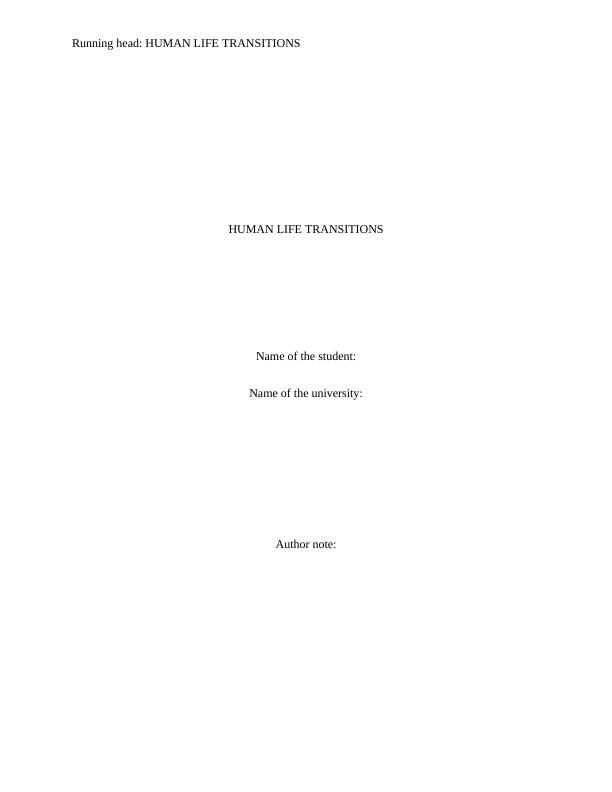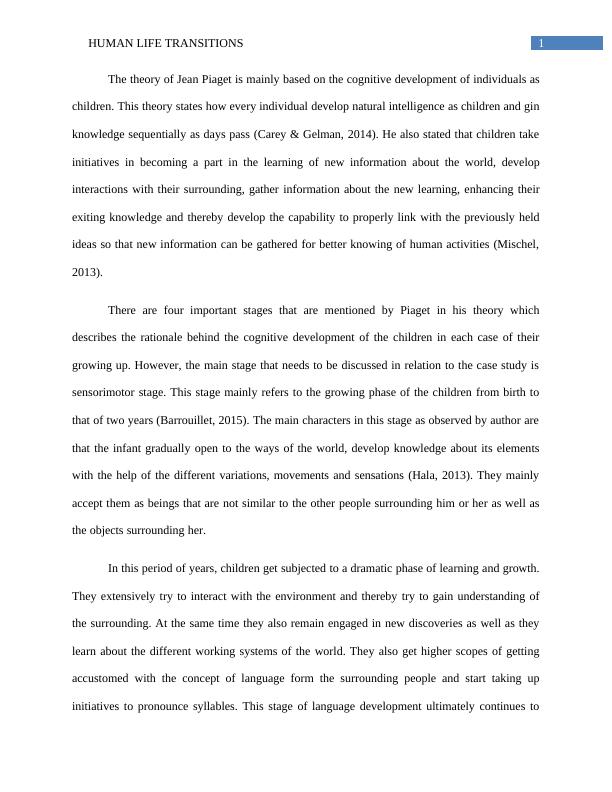Report on Human Life Transitions
Added on 2020-04-07
7 Pages1695 Words57 Views
Running head: HUMAN LIFE TRANSITIONSHUMAN LIFE TRANSITIONSName of the student:Name of the university:Author note:

1HUMAN LIFE TRANSITIONSThe theory of Jean Piaget is mainly based on the cognitive development of individuals aschildren. This theory states how every individual develop natural intelligence as children and ginknowledge sequentially as days pass (Carey & Gelman, 2014). He also stated that children takeinitiatives in becoming a part in the learning of new information about the world, developinteractions with their surrounding, gather information about the new learning, enhancing theirexiting knowledge and thereby develop the capability to properly link with the previously heldideas so that new information can be gathered for better knowing of human activities (Mischel,2013).There are four important stages that are mentioned by Piaget in his theory whichdescribes the rationale behind the cognitive development of the children in each case of theirgrowing up. However, the main stage that needs to be discussed in relation to the case study issensorimotor stage. This stage mainly refers to the growing phase of the children from birth tothat of two years (Barrouillet, 2015). The main characters in this stage as observed by author arethat the infant gradually open to the ways of the world, develop knowledge about its elementswith the help of the different variations, movements and sensations (Hala, 2013). They mainlyaccept them as beings that are not similar to the other people surrounding him or her as well asthe objects surrounding her.In this period of years, children get subjected to a dramatic phase of learning and growth.They extensively try to interact with the environment and thereby try to gain understanding ofthe surrounding. At the same time they also remain engaged in new discoveries as well as theylearn about the different working systems of the world. They also get higher scopes of gettingaccustomed with the concept of language form the surrounding people and start taking upinitiatives to pronounce syllables. This stage of language development ultimately continues to

2HUMAN LIFE TRANSITIONSthe nest stage with is named as the preoperational stage of the theory that mainly extends fromthe age of 2 to that of age 7 (Olson, 2013). At this stage, they mainly develop the ability to thinkand relate with objects symbolically. They also develop the power to learn and connect differentwords with the correct pictures to represent the objects.A number of different factors can be identified in the case study might have culminatedin appropriate speech development in the child. Jack was facing difficulty in developing speechas he did not have the opportunity to spend as much time with his mother or other familymembers which is required to develop the language skills. As his mother remains very busy withher work, she could not provide time and guidance to Jack. More people talk with him and urgehim to speak, the faster his language skill will develop. His mother had stated that he speaksvery little and blabbers his words which are not understandable. It has been explained in manyresearches that infants try their best to infer the communicative intent of the speaker which isthen utilized by the infants to guide their own learning of the language (Newman & Newman,2017). There are many articles which have supported the fact that a verbal environment becomesone of the factors in developing the language skills of children. Those infants who are comingfrom highly verbal professional families are fortunate to hear thrice more the number of wordsthan it is heard by the low verbal families. This in turn increases the chance of activeparticipation of the children in interaction sin the former case than the latter case. Similarly, incase of the child, as his mother used to work outside for a long time he got less scope of activeinteraction with adults which thereby resulted in not developing the urge to speak. Children whoare frequently exposed to high proportion of language in comparison to children who get normalordinary input of words learn the form of language at a higher rate than the others. As he is seento spend most of the time with children who are of the same stage and are also learning new

End of preview
Want to access all the pages? Upload your documents or become a member.
Related Documents
The Theory of John Piaget | Human Life Transitionslg...
|7
|1806
|68
Life Transitions | Cognitive Development | Assignmentlg...
|8
|1918
|356
Human Development and Lifespan Transition Issueslg...
|7
|1368
|31
Cognitive and Social Development of Children : Essaylg...
|6
|1588
|34
MGMT2009 - Process of Human Development and Life Transitionlg...
|7
|1795
|98
Social and Cognitive Development in Children Essaylg...
|7
|2003
|269
